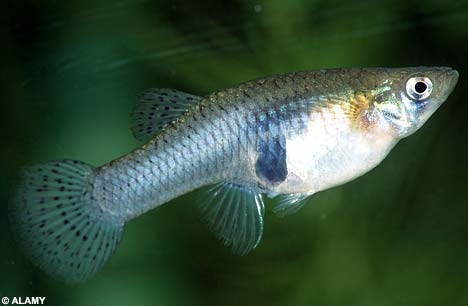The southern Chinese city of Guangzhou has introduced a fish that eats mosquito larvae, in an effort to control its worst-ever dengue fever outbreak, state news media have reported. Some scientists have warned that use of the nonnative mosquito fish could have unexpected consequences, while others say that mosquito fish are already found in Guangdong waters and the environmental impact might not be significant, but that the effectiveness of the fish may also be limited.
據(jù)國(guó)家媒體報(bào)道,為了控制當(dāng)?shù)赜惺芬詠?lái)最嚴(yán)重的登革熱疫情,中國(guó)南方城市廣州引進(jìn)了一種吃蚊子幼蟲的魚。一些科學(xué)家警告說(shuō),投放外來(lái)物種食蚊魚可能會(huì)產(chǎn)生意想不到的后果,但也有人說(shuō),廣東水域中已有食蚊魚,因此其環(huán)境影響可能不會(huì)太大,但這種魚的效果可能也很有限。

As of Monday, the number of dengue cases in Guangdong Province this year had reached 41,155, the local health authorities reported, with six deaths. The province has seen 200 to 300 new cases a day in recent days. That is lower than the more than 400 per day last week and the more than 1,000 per day the week before that, offering some hope that the outbreak is beginning to ease.
據(jù)當(dāng)?shù)匦l(wèi)生部門報(bào)告,截至周一,廣東省今年的登革熱發(fā)病人數(shù)已經(jīng)達(dá)到41,155人,其中有六人死亡。最近幾天中,全省每天有200到300個(gè)新病例出現(xiàn)。這比上周每天400例的新增病例要低,也比上上周的每天1,000例低得多,為疫情開始緩解帶來(lái)一些希望。
Guangzhou, the capital of Guangdong and China’s third-largest city, has seen the most cases, with more than 34,000 reported infections and one death, followed by the city of Foshan, with more than 3,000 cases and one death.
中國(guó)第三大城市、廣東省省會(huì)廣州市的疫情最嚴(yán)重,已有超過(guò)34,000個(gè)報(bào)告的感染病例、一人死亡,其次是佛山市,有3,000多個(gè)病例、一人死亡。
The dengue virus, which is carried by Aedes mosquitoes, can cause extreme fever, headaches, and muscle and joint pain in infected humans, though death is rare when proper treatment is provided. China has traditionally not seen large-scale outbreaks, but widespread urbanization and climate change have made warmer coastal areas increasingly hospitable to the mosquitoes that spread the virus.
登革熱病毒通過(guò)伊蚊傳播,能在被感染者身上引起高燒、頭痛,以及肌肉和關(guān)節(jié)疼痛,但在有適當(dāng)治療的情況下,很少有患者會(huì)死亡。中國(guó)很久以來(lái)已未曾出現(xiàn)過(guò)大規(guī)模的登革熱爆發(fā),但大范圍的城市化、以及氣候變化讓較溫暖的沿海地區(qū)越來(lái)越有利于傳播病毒的蚊子生存。
Officials, blaming the outbreak this year on inadequate mosquito control efforts, have increased the application of pesticides in Guangzhou in an effort to reduce the insect population. The city’s water bureau also announced on Oct. 15 that it had introduced mosquito fish from North America to “controllable static waters,” Xinhua, the state-run news agency, reported.
官員把今年的疫情暴發(fā)歸咎于控蚊工作做得不好,并已在廣州增加了殺蟲劑的使用,試圖減少蚊子的數(shù)量。據(jù)國(guó)家通訊社新華社報(bào)道,廣州水務(wù)局還在10月15日宣布,從北美引進(jìn)了食蚊魚以“控制靜態(tài)水體”。
That move prompted criticism from some experts who suggested it could upset the ecological balance in Guangdong waterways.
此舉遭到一些專家的批評(píng),他們認(rèn)為這個(gè)做法可能會(huì)破環(huán)廣東水域的生態(tài)平衡。
“The best solution to the dengue problem is to improve the overall environment,” Li Yanliang, chairman of the National Aquatic Wildlife Conservation Association, told Xinhua. “Introducing foreign species must be meticulous. The impacts must be controlled.”
全國(guó)水生野生動(dòng)物保護(hù)分會(huì)會(huì)長(zhǎng)李彥亮對(duì)新華社說(shuō),“登革熱的防治最好的辦法是提高整體的環(huán)境,對(duì)外來(lái)物種的引進(jìn)要慎重,嚴(yán)格控制外來(lái)物種帶來(lái)的負(fù)面影響。”
Liu Hansheng, an official with the Administration of Oceans and Fisheries, told Guangzhou Daily that the fish were invasive and that their introduction should be carefully controlled.
廣州市海洋與漁業(yè)自然保護(hù)區(qū)管理站救護(hù)部部長(zhǎng)劉漢生對(duì)《廣州日?qǐng)?bào)》說(shuō),食蚊魚是外來(lái)入侵物種,其投放應(yīng)受到嚴(yán)格控制。
“Previously the nation brought them in to help control mosquitoes, but afterward they spread,” Mr. Liu told the newspaper. “Whether or not this leads to a disaster, the city of Guangzhou at present doesn’t have enough data to say.”
劉漢生對(duì)該報(bào)說(shuō),“此前國(guó)家是將其作為滅蚊的幫手引進(jìn)中國(guó)的,但是后來(lái)就泛濫了,至于是否成災(zāi),廣州市暫時(shí)沒(méi)有調(diào)查數(shù)據(jù)可以支撐。”
Guangzhou Daily reported that the small, finger-length fish were first brought to China in 1924 and introduced to West Lake in Hangzhou. The fish then spread to other bodies of water, and since 2006 they have been introduced to parks in Guangzhou to control mosquitoes.
《廣州日?qǐng)?bào)》報(bào)道說(shuō),中國(guó)在1924年首次引進(jìn)這種手指長(zhǎng)短的小魚,投放在杭州的西湖。這種魚后來(lái)擴(kuò)散到其它水體,自2006年起,這種魚被引進(jìn)廣州的公園,以控制蚊子。
“Mosquito fishes are already widespread all over southern Guangdong, and I would doubt very much that adding any more would have much effect — either on the mosquitoes or on the ecology of the receiving waters,” David Dudgeon, a professor of ecology and biodiversity at the University of Hong Kong, wrote in an email.
“食蚊魚在廣東南部已很普遍,因此我不覺(jué)得,引進(jìn)更多魚會(huì)產(chǎn)生多大影響,無(wú)論是對(duì)蚊子,還是對(duì)接納水體的生態(tài)環(huán)境,”香港大學(xué)生態(tài)學(xué)及生物多樣性教授杜德俊(David Dudgeon)在電子郵件中寫道。
Scientific opinion on the effectiveness of the mosquito fish is divided, Dr. Dudgeon said. While the fish do eat mosquitoes, the insects are not the fish’s preferred food. And the mosquito fish can have a harmful effect by eating the eggs and larvae of other native species. If mosquitoes are breeding in flower pots, puddles and other small bodies of water where the fish aren’t introduced, then their effect will be further limited.
杜德俊說(shuō),科學(xué)家對(duì)食蚊魚的有效性存在意見(jiàn)分歧。雖然這種魚的確吃蚊子,但蚊子不是其首選食品。而食蚊魚也吃其他本地物種的卵和幼蟲,因此可能產(chǎn)生有害影響。如果蚊子在花盆、水坑和其他小水體中繁殖,而不把魚引進(jìn)這些水體的話,其作用將進(jìn)一步受到限制。












